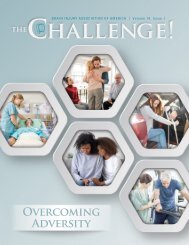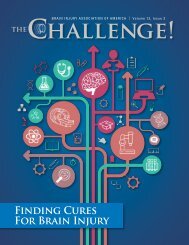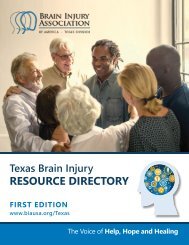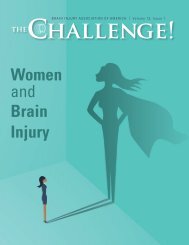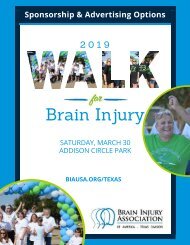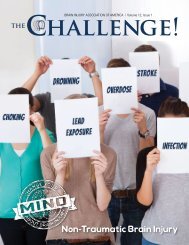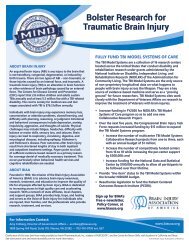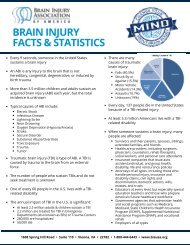THE Challenge! Spring 2011
Communication
Communication
Create successful ePaper yourself
Turn your PDF publications into a flip-book with our unique Google optimized e-Paper software.
From my desk<br />
President’s Message<br />
Americans shell out $1.5 trillion<br />
each year for insurance<br />
premiums. We buy financial<br />
protection for ourselves and our<br />
possessions so that we can sleep better<br />
at night. Frequently that protection<br />
falls short of our needs. Sometimes it<br />
is because we are tricked by the “fine<br />
print,” but more often key terms and<br />
conditions are presented upfront and in<br />
plain sight – we just don’t know what<br />
they mean.<br />
Recently I learned that when your home<br />
is destroyed, by a flood for example, a<br />
typical homeowners’ policy will pay for<br />
you to live elsewhere while your home<br />
is rebuilt. The catch is, you only get one<br />
year of free rent. For many families,<br />
12 months is not enough time to assess the damage, clear the<br />
debris, hire an architect, obtain the permits, build a new place<br />
and furnish it in your own way. This is especially true if your<br />
home is destroyed in a common disaster. When the demand<br />
for rebuilding is high, the process slows down and the costs<br />
skyrocket so standard coverage is insufficient.<br />
Just like homeowners insurance, health insurance is often<br />
inadequate in catastrophic situations. Lengths of stay aren’t<br />
long enough, there aren’t enough specialized providers in the<br />
network and there’s too much paperwork and red tape. And just<br />
like building a new home, rehabilitation is a slow, sometimes<br />
painful, process. The outside walls go up quickly, but the inside<br />
work takes a long, long time. And like home maintenance,<br />
disease management is an ongoing process.<br />
Whether buying homeowners insurance or health insurance,<br />
most people agree that “hindsight” is 20/20. Wouldn’t it be<br />
great if “foresight” were 20/20 too? That is, wouldn’t it be<br />
great if we knew what we were buying before we bought it?<br />
One of the goals of the health reform law is to make health<br />
insurance plans more transparent. The Patient Protection and<br />
Affordable Care Act authorizes the National Association of<br />
Insurance Commissioners to work with stakeholders to develop<br />
“coverage facts labels.” These labels will be similar to the<br />
nutrition facts labels on the food we buy – the labels will tell<br />
us what’s inside the policy. Information labels sound like a<br />
good idea until we remember that some people don’t know how<br />
much protein or sodium they need and even fewer know what<br />
trans fat or dietary fiber are!<br />
Over the last 30 years, individuals with<br />
brain injury have learned the hard way<br />
that OT, PT, speech, personal care and a<br />
wide range of other services are needed<br />
after brain injury. Of course, everyone is<br />
different so the type and amount of each<br />
therapy or service needed vary widely.<br />
As advocates, it is our job to raise<br />
awareness of brain injury and to help<br />
others understand the complex issues<br />
individuals and families face every day.<br />
As advocates, it is our job to communicate<br />
our needs, goals and choices to friends,<br />
family, professionals and the general<br />
public, including lawmakers.<br />
This issue of <strong>THE</strong> <strong>Challenge</strong>! is all about<br />
communication. It describes why speech<br />
language, receptive learning and word<br />
finding is sometimes difficult after brain injury. It offers useful<br />
tips for talking with others after the injury. It explains why many<br />
people in the field are now thinking of and talking about brain<br />
injury as a chronic disease.<br />
This issue also highlights the presentation delivered by Anne<br />
Forrest during Awareness Day on Capitol Hill, as well as the<br />
remarks of Rep. Bill Pascrell, Jr. and legislative staff from Rep.<br />
Gabrielle Giffords’ office, who joined BIAA’s National Medical<br />
Director Dr. Brent Masel at a recent press conference to urge<br />
Health and Human Services Secretary Kathleen Sebelius to<br />
write favorable regulations under the Affordable Care Act.<br />
As always, <strong>THE</strong> <strong>Challenge</strong>! includes an update on federal<br />
advocacy activities and news and notes from BIAA’s chartered<br />
state affiliates, including the successful Brain Injury Awareness<br />
Month activities conducted across the country. Last, but<br />
definitely not least, this issue sends a great big shout out to<br />
the individuals and organizations that generously support our<br />
mission. Personal donations and corporate sponsorships make<br />
our day-to-day work possible. We are truly grateful.<br />
Susan H. Connors, President/CEO<br />
Brain Injury Association of America<br />
<strong>THE</strong> <strong>Challenge</strong>! | <strong>Spring</strong> <strong>2011</strong><br />
2




